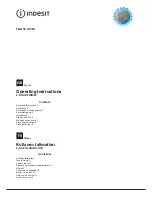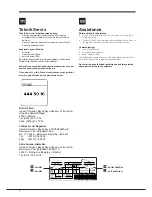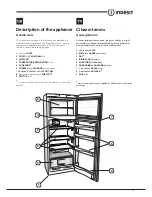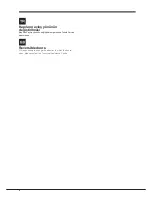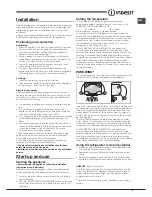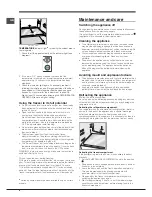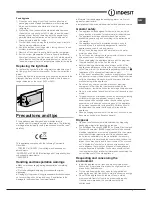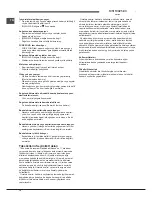
GB
7
Food hygiene
1. Once you have bought your food, remove all external
packaging made of paper/cardboard or other wrappers,
which could introduce bacteria or dirt inside your
refrigerator.
2. Protect the food, (especially easily perishable items and
those that have a strong smell), in order to avoid contact
between them, thereby removing both the possibility of
germ/bacteria contamination as well as the diffusion of
strong odours inside the fridge.
3. Store all food in such a way as to ensure air can circulate
freely between different items.
4. Keep the inside of your fridge clean, taking care not to use
oxidiser or abrasive products.
5. Remove all food past its expiry date from the refrigerator.
6. For the correct preservation of food, all easily perishable
items (soft cheeses, raw fish, meat, etc.) should be stored in
the coldest zone of the fridge compartment, i.e. just above
the salad crisper where the temperature indicator is situated.
Replacing the light bulb
To replace the light bulb in the refrigerator compartment, pull
out the plug from the electrical socket. Follow the instructions
below.
Access the light bulb by removing the cover as indicated in the
diagram. Replace it with a similar light bulb within the power
range indicated on the cover (15W or 25W).
1
2
Precautions and tips
!
The appliance was designed and manufactured in
compliance with international safety standards. The following
warnings are provided for safety reasons and must be read
carefully.
This appliance complies with the following Community
Directives:
- 73/23/EEC of 19/02/73 (Low Voltage) and subsequent
amendments;
-89/336/EEC of 03.05.89 (Electromagnetic Compatibility) and
subsequent amendments;
- 2002/96/CE..
Handling and transportation warnings
• Make sure the packaging during transportation completely
closed,
• Do the handling and shipping processes with original
packaging.
• Damage to the product during transport and breakdown does
not occur, hitting, shock, drop and so on. Pay attention to the
damage to the product due to external factors.
• Moisture that can damage the packaging, water, etc. Protect
against external factors.
• Installation of the device will be carried out by authorized service
General safety
• The appliance was designed for domestic use inside the
home and is not intended for commercial or industrial use.
• The appliance must be used to store and freeze food
products by adults only and according to the instructions in
this manual.
• The appliance must not be installed outdoors, even in
covered areas. It is extremely dangerous to leave the
appliance exposed to rain and storms.
• Do not touch the appliance with bare feet or with wet or
moist hands and feet.
• Do not touch the internal cooling elements: this could cause
skin abrasions or frost/freezer burns.
• When unplugging the appliance always pull the plug from
the mains socket, do not pull on the cable.
• Before cleaning and maintenance, always switch off the
appliance and disconnect it from the electrical supply. It is
not sufficient to set the temperature adjustment knobs on
(appliance off) to eliminate all electrical contact.
• In the case of a malfunction, under no circumstances should
you attempt to repair the appliance yourself. Repairs carried
out by inexperienced persons may cause injury or further
malfunctioning of the appliance.
• Do not use any sharp or pointed utensils or electrical
equipment - other than the type recommended by the
manufacturer - inside the frozen food storage compartments.
• Do not put ice cubes taken directly from the freezer into your
mouth.
• This appliance is not intended for use by persons (including
children) with reduced physical, sensory or lack of
experience and knowledge unless they have been given
supervision or instruction concerning use of the appliance
by a person responsible for their safety. Children should
be supervised to ensure that they do not play with the
appliance.
• Keep packaging material out of the reach of children! It can
become a choking or suffocation hazard.
Disposal
• Observe local environmental standards when disposing
packaging material for recycling purposes.
• The European Directive 2002/96/EC on Waste Electrical and
Electronic Equipment (WEEE), requires that old household
electrical appliances must not be disposed of in the normal
unsorted municipal waste stream. Old appliances must
be collected separately in order to optimise the recovery
and recycling of the materials they contain and reduce the
impact on human health and the environment. The crossed
out “wheeled bin” symbol on the product reminds you of
your obligation, that when you dispose of the appliance it
must be separately collected. Consumers should contact
their local authority or retailer for information concerning the
correct disposal of their old appliance.
Respecting and conserving the
environment
• Install the appliance in a fresh and well-ventilated room.
Ensure that it is protected from direct sunlight and do not
place it near heat sources.
• Try to avoid keeping the door open for long periods or
opening the door too frequently in order to conserve energy.
• Do not fill the appliance with too much food: cold air
must circulate freely for food to be preserved properly.
If circulation is impeded, the compressor will work
continuously.

